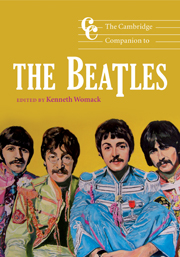Book contents
- Frontmatter
- Introducing the Beatles
- Part I Background
- Part II Works
- 3 Rock and roll music
- 4 “Try thinking more”: Rubber Soul and the Beatles' transformation of pop
- 5 Magical mystery tours, and other trips: yellow submarines, newspaper taxis, and the Beatles' psychedelic years
- 6 Revolution
- 7 On their way home: the Beatles in 1969 and 1970
- 8 Apple Records
- 9 The solo years
- 10 Any time at all: the Beatles' free phrase rhythms
- Part III History and influence
- Notes
- Beatles discography, 1962–1970
- Select bibliography
- Index
4 - “Try thinking more”: Rubber Soul and the Beatles' transformation of pop
from Part II - Works
Published online by Cambridge University Press: 28 September 2011
- Frontmatter
- Introducing the Beatles
- Part I Background
- Part II Works
- 3 Rock and roll music
- 4 “Try thinking more”: Rubber Soul and the Beatles' transformation of pop
- 5 Magical mystery tours, and other trips: yellow submarines, newspaper taxis, and the Beatles' psychedelic years
- 6 Revolution
- 7 On their way home: the Beatles in 1969 and 1970
- 8 Apple Records
- 9 The solo years
- 10 Any time at all: the Beatles' free phrase rhythms
- Part III History and influence
- Notes
- Beatles discography, 1962–1970
- Select bibliography
- Index
Summary
The new songs had no humility. They pushed past the veil and opened a window into the darkness and climbed through it with a knife in their teeth . . . . They were beautiful songs, full of places and textures – flesh, velvet, concrete, city towers, desert sand, snakes, violence, wet glands, childhood, the pure wings of night insects. Anything you could think of was there, and you could move through it as if it were an endless series of rooms and passages full of visions and adventures. And even if it was about killing and dying – that was just another place to go.
mary gaitskill, veronicaWhile Mary Gaitskill's character Alison Owen does not refer to the Beatles in the above epigraph, the musical and lyrical range of what she deems the “new songs” owes a tremendous debt to the group from Liverpool. While some early pop artists, such as Chuck Berry, had occasionally explored topics other than puppy love, teen angst, and the exuberance of youth, serious considerations of subjects beyond this terrain fell mainly to performers in the traditional and folk genres, and few ever reached the level of “visions and adventures.” Indeed, had a few brave souls forayed into this uncharted territory, the audience might have taunted them off the stage. Starting with A Hard Day's Night, however, and reaching fruition in Rubber Soul and Revolver, the Beatles crossed a the matic threshold that would both inspire their pop contemporaries and develop an audience ready for songs about more than hand-holding and whispered secrets. It is no coincidence that Rubber Soul took its narrative cues more from folk crossovers such as Bob Dylan and the Byrds than from the Beatles' pop cohorts. Sonically the influences were numerous, from the soul alluded to in the album's title to country and western and Indian sitar music.
Remarkably, while critics inevitably cite Rubber Soul as the Beatles' “transitional” album, the shift from successful pop act to unparalleled masters of the studio took but three years. Ultimately, the demarcation between Beatlemania and the studio years proves an arbitrary one, for from the beginning the Beatles, especially John Lennon, showed a lyrical uneasiness with their expected subject matter.
- Type
- Chapter
- Information
- The Cambridge Companion to the Beatles , pp. 75 - 89Publisher: Cambridge University PressPrint publication year: 2009
- 3
- Cited by



